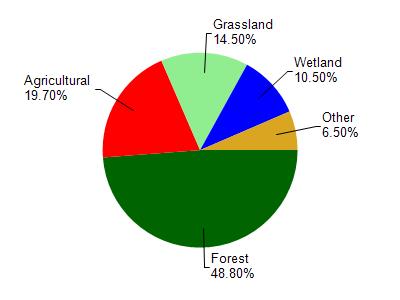Barron
No
No
Yes
Fish and Aquatic Life
Overview
Tenmile Lake, in the Lake Chetek Watershed, is a 265.77 acre lake that falls in Barron County. This lake is managed for fishing and swimming and is currently considered impaired.
Date 2011
Author Aquatic Biologist
Historical Description
Source: 1964, Surface Water Resources of Barron County Tenmile Lake T33N, R10W, Sections 27, 28, 32, 33
A soft water drainage impoundment in the Chetek Lake Chain. The lake level is controlled by the outlet dam on Lake Chetek. Fish species counted here include walleyes, northern pike, largemouth bass, perch, bluegills, black crappies, pumpkinseeds, bullheads and white suckers. Excessive algae growth complicates use and management. Muskrats, nesting mallards and wood ducks use the 27 acres of lake edge wetlands. Tenmile Lake is also quite highly developed with two resorts and 69 cottages and homes. It is accessible at two public boat landings on the east shore. A county park also on the east shore provides picnicking and camping facilities. A total of 0.05 miles of public frontage is available on the lake. This figure includes the developed access sites, the county park and seven undeveloped platted accesses.
Surface Acres = 393.0, S.D.F. - 2.07, Maximum Depth = 10 feet
Date 1964
Author Surface Water Inventory Of Wisconsin
Condition
Wisconsin has over 84,000 miles of streams, 15,000 lakes and milllions of acres of wetlands. Assessing the condition of this vast amount of water is challenging. The state's water monitoring program uses a media-based, cross-program approach to analyze water condition. An updated monitoring strategy (2015-2020) is now available. Compliance with Clean Water Act fishable, swimmable standards are located in the Executive Summary of Water Condition in 2018. See also the 'monitoring and projects' tab.
Reports
Management Goals
Wisconsin's Water Quality Standards provide qualitative and quantitative goals for waters that are protective of Fishable, Swimmable conditions [Learn more]. Waters that do not meet water quality standards are considered impaired and restoration actions are planned and carried out until the water is once again fishable and swimmable
Management goals can include creation or implementation of a Total Maximum Daily Load analysis, a Nine Key Element Plan, or other restoration work, education and outreach and more. If specific recommendations exist for this water, they will be displayed below online.
Monitoring
Monitoring the condition of a river, stream, or lake includes gathering physical, chemical, biological, and habitat data. Comprehensive studies often gather all these parameters in great detail, while lighter assessment events will involve sampling physical, chemical and biological data such as macroinvertebrates. Aquatic macroinvertebrates and fish communities integrate watershed or catchment condition, providing great insight into overall ecosystem health. Chemical and habitat parameters tell researchers more about human induced problems including contaminated runoff, point source dischargers, or habitat issues that foster or limit the potential of aquatic communities to thrive in a given area. Wisconsin's Water Monitoring Strategy was recenty updated.
Grants and Management Projects
Monitoring Projects
| WBIC | Official Waterbody Name | Station ID | Station Name | Earliest Fieldwork Date | Latest Fieldwork Date | View Station | View Data |
|---|
| 2089500 | Tenmile Lake | 033152 | Tenmile Lake - N of Cty Park | 6/5/1987 | 9/16/2024 | Map | Data |
| 2089500 | Tenmile Lake | 10030257 | Tenmile Lake at 26 1/2 - 27th St | | | Map | Data |
| 2089500 | Tenmile Lake | 10018435 | Tenmile Lake -- Access | 8/8/2007 | 7/21/2011 | Map | Data |
| 2089500 | Tenmile Lake | 10000758 | Tenmile Lake | 9/5/2000 | 8/19/2017 | Map | Data |
|

Watershed Characteristics
Tenmile Lake is located in the Lake Chetek watershed which is 212.00 mi². Land use in the watershed is primarily forest (48.80%), agricultural (19.70%) and a mix of grassland (14.50%) and other uses (17.00%). This watershed has 270.25 stream miles, 2,008.86 lake acres and 10,678.22 wetland acres.
Nonpoint Source Characteristics
This watershed is ranked Medium for runoff impacts on streams, High for runoff impacts on lakes and High for runoff impacts on groundwater and therefore has an overall rank of High. This value can be used in ranking the watershed or individual waterbodies for grant funding under state and county programs.However, all waters are affected by diffuse pollutant sources regardless of initial water quality. Applications for specific runoff projects under state or county grant programs may be pursued. For more information, go to surface water program grants.